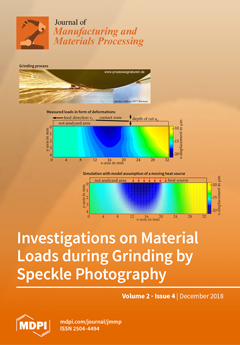Currently, because of stricter environmental standards and highly competitive markets, machining operations, as the main part of the manufacturing cycle, need to be rigorously optimized. In order to simultaneously maximize the production quality and minimize the environmental issues related to the grinding process,
[...] Read more.
Currently, because of stricter environmental standards and highly competitive markets, machining operations, as the main part of the manufacturing cycle, need to be rigorously optimized. In order to simultaneously maximize the production quality and minimize the environmental issues related to the grinding process, this research study evaluates the performance of minimum quantity lubrication (MQL) grinding using water-based nanofluids in the presence of horizontal ultrasonic vibrations (UV). In spite of the positive impacts of MQL using nanofluids and UV which are extensively reported in the literature, there is only a handful of studies on concurrent utilization of these two techniques. To this end, for this paper, five kinds of water-based nanofluids including multiwall carbon nanotube (MWCNT), graphite, Al
2O
3, graphene oxide (GO) nanoparticles, and hybrid Al
2O
3/graphite were employed as MQL coolants, and the workpiece was oscillated along the feed direction with 21.9 kHz frequency and 10 µm amplitude. Machining forces, specific energy, and surface quality were measured for determining the process efficiency. As specified by experimental results, the variation in the material removal nature made by ultrasonic vibrations resulted in a drastic reduction of the grinding normal force and surface roughness. In addition, the type of nanoparticles dispersed in water had a strong effect on the grinding tangential force. Hybrid Al
2O
3/graphite nanofluid through two different kinds of lubrication mechanisms—third body and slider layers—generated better lubrication than the other coolants, thereby having the lowest grinding forces and specific energy (40.13 J/mm
3). It was also found that chemically exfoliating the graphene layers via oxidation and then purification prior to dispersion in water promoted their effectiveness. In conclusion, UV assisted MQL grinding increases operation efficiency by facilitating the material removal and reducing the use of coolants, frictional losses, and energy consumption in the grinding zone. Improvements up to 52%, 47%, and 61%, respectively, can be achieved in grinding normal force, specific energy, and surface roughness compared with conventional dry grinding.
Full article





